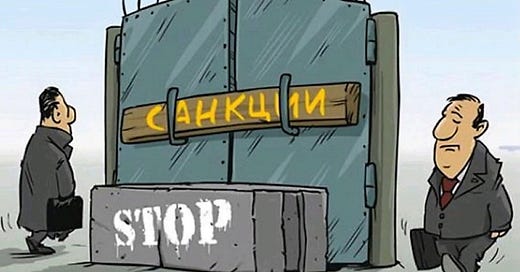Assessing the effectiveness of Western sanctions imposed on Russia, I often emphasize the adaptability of the economy, which can adjust to various constraints. In this context, financial sanctions are usually the first to lose their impact, despite their initial swift effect. Allow me to illustrate this through a practical example.
On March 2, 2022, the EU banned the export of banknotes (cash euros) to Russia, followed by a similar ban on dollar banknotes signed by President Biden on March 11, 2022. These measures were intended to destabilize the Russian financial market, increase dissatisfaction among wealthy Russians, and reduce support for the Kremlin’s aggressive policies.
Initially, this ban proved highly effective, resulting in a significant disparity between the exchange rate of cash dollars and the interbank rate, reaching 8%-10%. Furthermore, the Bank of Russia introduced restrictions on withdrawing cash foreign currency from foreign currency deposits to Russian residents. However, over time, the gap in exchange rates gradually narrowed, and today it has completely disappeared. I see three explanations for this.
First, we can attribute the decrease in demand for cash foreign currency among Russians to a substantial decline in international travel. Notably, in destinations like Abkhazia, Russian payment cards and cash rubles are widely accepted without restrictions, while in Turkey, it is relatively easy for Russians to open a local bank account. These two destinations account for more than 44% of Russians’ overseas trips, 73% combined with CIS countries where ruble is widely accepted.1
Second, Russian citizens have substantially reduced their foreign currency deposits in banks by transferring them abroad or converting them into ruble deposits.
Last, Russian banks have managed to arrange the import of cash dollars through neighboring countries that maintain persistent negative current account balances with Russia and are willing to accept ruble payments.
Consequently, in less than a year and a half, the impact of the imposed sanctions on Russia has diminished, and their influence on the country’s affairs has waned.
The same can be applied to several other sanction actions. For instance, the ban on Russian oil and coal imports to the European Union did not decrease Russian exports of those goods. Russian companies took several months to redirect their exports to alternative markets. Comparably, Russian steel manufacturers, affected by similar bans, found solutions by shifting their focus to exporting products with lower added value. However, certain Russian companies are still grappling with the situation. The wood processing sector has been particularly impacted, with plywood production declining by 40% following the EU import ban, without any signs of immediate recovery. Nevertheless, it should be no surprise that this industry will gradually regain its footing over the next few years.
In summary, sanctions do have an impact on the economy, but their intensity diminishes over time. The primary long-term consequence of prolonged sanctions is the lag in technological advancements and the aging of the economy. It is important to note that this does not imply an economic collapse or the cessation of growth.
Federal Security Service (FSB) data from April 2022 to March 2023, inclusive.





DW published an interesting documentary last week, showing how the EU is exporting to Russia via Georgia and other bordering countries - https://youtu.be/z7yofon22AM